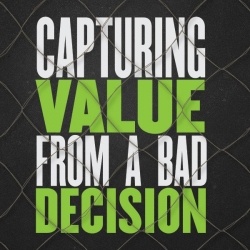 Unless you’re superhuman, odds are that you are going to make a wrong choice for your organization at some point.
Unless you’re superhuman, odds are that you are going to make a wrong choice for your organization at some point.
It doesn’t matter how well-informed you are, how careful you have been in specifying the problem, how much data and information you have collected, or how systematic you have been in the decision process—mistakes can still happen.
But that doesn’t mean you don’t still try to avoid it. You have to learn to frame your decisions and proceed through the process to reduce the chances and consequences of a wrong choice, and how to turn failure into success.
Essentially, reducing the consequences of making the wrong choice is all about framing the process as “learning by doing.”
Fail fast, fail cheap, move on
Most strategic decisions should be structured using an options framework, a multi-step process in which you limit initial financial and resource commitments, gain insights on how to proceed from the initial “experiment,” and take the time to gather additional information before making further commitments. This approach is structured to reduce the potential loss of a decision, but maintain and expand the potential.
This framework is described in the venture capital world as, “Fail fast, fail cheap, move on.” It’s also a stark contrast to the “big bet” approach, which encompasses a full-blown upfront commitment of time and resources to a project or venture.
In their book, “Discovery Driven Growth,” Rita Gunther McGrath and Ian MacMillan describe a process by which decision-makers use a systemized structure for gleaning the most information possible from the experiment phase. That means using a sequence of planning the experiment, implementing the plan, learning from the experiment to update and modify the plan, and developing a revised plan—then continuing the cycle until you can make a decision. Planning is structured with the end in mind, using reverse financials and specifying deliverables based on an assumption checklist.
Factors to consider include the revenue or sales required, margins needed, and costs allowed to meet the specified expected income profit. Also necessary to consider are the financial and managerial resources needed to generate the specified income or profit. Calculating all of these will verify that the project or venture will meet the goals for return on assets (ROA).
Know when to kill a project
Some projects and initiatives simply won’t succeed after the initial experiment is finished. In these cases, it’s best not to proceed with the full-blown commitment. In an uncertain environment, it is essential to prune or cut back activities or initiatives when the business climate changes, the market doesn’t develop as expected or the financial performance doesn’t meet expectations.
Transforming a termination decision from a failure to an event that creates value for the organization requires a four-part disengagement plan:
1. Outline a concrete plan and have an honest discussion with disappointed stakeholders, including investors, shareholders, employees, lenders, suppliers, customers and the distribution channel to explain how and why the shutdown decision was made and what will be done to minimize the negative impacts on them.
2. Compose an analysis and synopsis of the insights obtained from the initiative so that they might inform future decisions and current or future projects and activities. This analysis should include insights concerning product performance, customer responses, distribution channels, technology strengths or flaws, and strengths and shortcomings of people, processes, suppliers and partners. Such an analysis starts with the original assumptions, then proceeds through new learnings and concludes with insights that will inform the next step.
3. Perform a disengagement opportunity review to determine what insights to communicate with others in the organization, as well as those directly involved in the venture, including employees, suppliers, distributors, partners and other stakeholders. The point is to capture and catalog the full learning potential of the initiative.
4. Capture any remaining financial value of the venture through a spin-off, joint venture, licensing or sale of physical assets and intangibles, such as knowledge or brand value.
Strategic Decision Making
Purdue University’s Center for Food and Agricultural Business annually offers a training seminar focused solely on helping you make the right decisions for your organization. Strategic Decision Making runs each June in West Lafayette. Learn more.
About the authors
Michael Boehlje is a distinguished professor of agricultural economics at Purdue University and a faculty instructor for the Center for Food and Agricultural Business. His research and teaching areas focus on farm and agribusiness management and finance.
Jennifer Stewart-Burton is the content marketing and social media manager for the Purdue University Center for Food and Agricultural Business.
:



